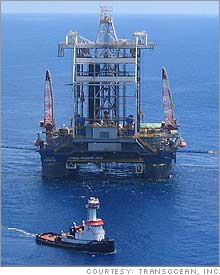|
Major U.S. oil source is tapped Successful test by Chevron partners in deep Gulf waters could rival Alaska in potential supply; U.S. reserves may swell 50 percent. NEW YORK (CNNMoney.com) -- Chevron and its partners have successfully extracted oil from a test well in the deep waters of the Gulf of Mexico, an achievement that could be the biggest breakthrough in domestic oil supplies since the opening of the Alaskan pipeline. The news sent oil prices lower, with U.S. light crude for October delivery sinking 69 cents to $68.50 on the New York Mercantile Exchange.
The announcement helped dampen fears that oil supplies would be swamped by growing global demand, a concern that helped lift oil to record highs this summer, unadjusted for inflation. But experts cautioned that relief at the pump from the breakthrough is many years away. "It sounds terrific, but this means nothing for the near-term period," said Tom Kloza, chief oil analyst for the Oil Price Information Service, which surveys gasoline prices daily for AAA. "But it should remind everyone that before they buy into the reckoning of $100 a barrel oil that all those estimates don't take into account tremendous amount of money can be spent on exploration when prices are at these levels." Shares of the three partners in the test well known as "Jack 2" rose sharply in trading Tuesday. Chevron (up $1.51 to $66.34, Charts), which owns a 50 percent stake, jumped 3 percent, while Devon Energy (up $7.99 to $72.14, Charts) soared nearly 12 percent, and Norwegian oil company Statoil (up $0.66 to $28.17, Charts)'s U.S. shares added about 2 percent. Devon and Statoil each own 25 percent stakes. Shares of other major oil companies with rights to this area of the Gulf, including Exxon Mobil (Charts), BP (Charts) and Royal Dutch Shell (Charts), rose modestly on the news. Neither Chevron nor Devon would say how long it would take for oil from the well to reach market. Experts say it will take billions of dollars to build the deepwater oil platforms and pipelines needed to extract the oil and get it into world markets. "At best we're not going to see a drop of oil for five years, maybe seven years," said Fadel Gheit, oil analyst for Oppenheimer. "It's great news for Chevron and even more so for Devon. But you can't hold your breath waiting for it." A boon for the United States Almost all the oil platforms in the Gulf are relatively close to the shore, on a shelf that puts them in less than 1,700 feet of water. In recent years, oil has been found in the deeper waters of the Gulf known as the "lower tertiary" area, where the water is between 5,000 to 10,000 feet deep, but it had yet to be proved that oil could be extracted in enough volume to make such finds practical. The Jack 2 well, which is 175 miles offshore, is in more than 7,000 feet of water and then drilled through more than 20,000 feet of rock below the sea floor, or about five miles below the surface of the Gulf. Chevron said the test had a flow rate of more than 6,000 barrels of crude oil a day. Chevron would not estimate how much its reserves would be increased as a result of the test, nor would Devon. But Chevron said that it now believes the lower tertiary region of the Gulf could hold reserves of 3 billion to 15 billion barrels of oil. Total established U.S. reserves are estimated at less than 30 billion barrels. "Until now no one was sure if the oil in this play would flow," said Zoe Sutherland, North American oil exploration analyst for Wood Mackenzie, a global oil research and consulting firm. "It doesn't matter how many large discoveries you have if you can't produce it. This is very exciting news." Sutherland said it is fair to compare the breakthrough with the opening up of the North Slope of Alaska in terms of U.S. supply. Ohio Northern University Professor A. F. Alhajji said the implications of this successful test could also help to open greater offshore supplies at other fields around the globe. He said that could mean even greater addition to worldwide reserves than those that now seem to be within reach in the Gulf. "Whatever technology they used, I can tell you companies are scrambling right now to try to use it," said Alhajji. Gheit said that it is only with oil at its current historically high prices that exploration at these depths really became economically practical. "This is the silver lining of higher oil prices," he said. "If we didn't have higher oil prices, they wouldn't have dared to risk this much capital here." |
|

